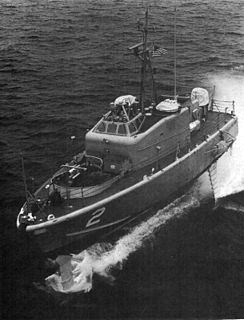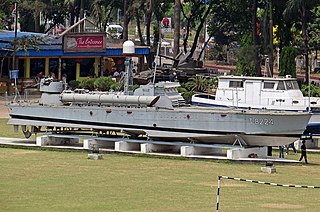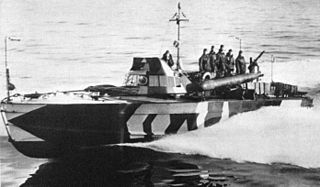
A hydrofoil is a lifting surface, or foil, that operates in water. They are similar in appearance and purpose to aerofoils used by aeroplanes. Boats that use hydrofoil technology are also simply termed hydrofoils. As a hydrofoil craft gains speed, the hydrofoils lift the boat's hull out of the water, decreasing drag and allowing greater speeds.
The United States Navy, United States Coast Guard, and United States National Oceanic and Atmospheric Administration (NOAA) use a hull classification symbol to identify their ships by type and by individual ship within a type. The system is analogous to the pennant number system that the Royal Navy and other European and Commonwealth navies use.
A patrol boat is a relatively small naval vessel generally designed for coastal defence, border protection, immigration law-enforcement, search and rescue duties. There have been many designs for patrol boats. They may be operated by a nation's navy, coast guard, police force or customs and may be intended for marine or estuarine or river environments. They are commonly found engaged in various border protection roles, including anti-smuggling, anti-piracy, fisheries patrols, and immigration law enforcement. They are also often called upon to participate in rescue operations.

The term brown-water navy or riverine navy refers in its broadest sense to any naval force capable of military operations in littoral zone waters. The term originated in the United States Navy during the American Civil War, when it referred to Union forces patrolling the muddy Mississippi River, and has since been used to describe the small gunboats and patrol boats commonly used in rivers, along with the larger "mother ships" that supported them. These mother ships include converted World War II-era Landing Crafts and Tank Landing Ships, among other vessels.

The Romanian Navy is the navy branch of the Romanian Armed Forces; it operates in the Black Sea and on the Danube. It traces its history back to 1860.

The motor gun boat (MGB) was a small, high-speed British military vessel of the Second World War, which was armed with a mix of guns, in contrast to the physically similar motor torpedo boat (MTB), whose main offensive weapon were torpedoes. The small size of the MGBs, and their high speed, made them difficult targets for German E-boats, though, like their opponents, they were limited by heavy weather, because they did not provide a stable-enough platform to aim the guns. The large number of guns meant the crew was relatively large, numbering as high as thirty men on the largest boats.

The USS Tucumcari (PGH-2) was a Boeing-built hydrofoil. Named after Tucumcari, New Mexico, it was the basis for the technology used in the subsequent Pegasus-class patrol boats and the Jetfoil ferries. Its unique feature was a waterjet propulsion and a computer-controlled fully submerged foil configuration of one foil at the bow and foils on the port and starboard sides. The Tucumcari was one of two prototype boats contracted by the Navy under project SCB 252 for the purpose of evaluating the latest hydrofoil technology. The second boat was the rival Grumman-built USS Flagstaff (PGH-1).

The P 4 class torpedo boat (TB) were aluminum-hulled torpedo boats of the People's Republic of China's People's Liberation Army Navy. Based on the Soviet K-123 hydroplane design, they were armed with twin 14.5-millimetre (0.57 in) machine guns, and two 17-inch (43 cm) torpedoes. This class is currently considered obsolete, but was not completely retired from active service, being placed in reserve until the mid-1990s.

The Type 025 torpedo boat, also known as the Huchuan or Hu Chwan class, was once the backbone of the People's Liberation Army Navy (PLAN) in its confrontations with its much larger opponents in the Republic of China Navy. Although no longer serving in that capacity, this class is still active. While relatively unsophisticated, the class has enjoyed a longevity in active service thanks to a philosophy within PLAN which has continued to favor its use. Powered by Soviet-era engines, the hydrofoil-equipped boats are capable of 50 knots and carry two torpedo tubes for torpedoes, with some known to be armed with naval mines.
The Type 024 missile boat is a Chinese built small missile boat armed with two anti-ship missiles and there were two versions developed. Although most have been placed in reserve, dozens remain in active service. Those in active service have been rearmed with C-101 supersonic anti-ship missiles.

Motoscafo armato silurante, commonly abbreviated as MAS was a class of fast torpedo-armed vessels used by the Regia Marina during World War I and World War II. Originally, "MAS" referred to motobarca armata SVAN (armed motorboat SVAN, Società Veneziana Automobili Navali.

Coastal Forces was a division of the Royal Navy initially established during World War I, and then again in World War II under the command of Rear-Admiral, Coastal Forces. It remained active until the last minesweepers to wear the "HM Coastal Forces" cap tally were taken out of reserve in 1968. On 21 May 2020, Ministerial approval for the change in name from 1st Patrol Boat Squadron to Coastal Forces Squadron was given. It encompasses the Archer-class patrol vessels and the Batch 1 River-class offshore patrol vessels and are responsible for UKEEZ Protection and Patrol.
HMS Fervent was a Fervent-class destroyer which served with the Royal Navy. Fervent was launched on 28 March 1895 at Paisley.

HMS Zephyr was one of two Fervent-class destroyers which served with the Royal Navy. She was launched on 10 May 1895 from Hanna, Donald & Wilson at Paisley, Scotland. She served in home waters, and was sold in 1920.

Steam gun boats (SGBs) were small Royal Navy vessels built from 1940 to 1942 for Coastal Forces during the Second World War. The class consisted of nine steam-powered torpedo boats.
The Dnieper Flotilla is the name given to the various naval flotillas on the Dnieper River. These were particularly active in four conflicts: the Russo-Turkish wars of 1735–39 and 1787–92, the Russian Civil War, and World War II.
The Type 271 landing craft is a family landing craft of the People's Liberation Army Navy (PLAN). Most models in this class are landing craft utility (LCU)s, but the last model has been developed into a Landing ship medium (LSM).
Type 02 torpedo boat is a family of Chinese torpedo boats developed from Soviet P-6 class torpedo boat, and these boats have since retired from active service in the People's Liberation Army Navy (PLAN).
Type 52 gunboat was a type of gunboat developed by China for the People's Liberation Army Navy (PLAN) in the early 1950s, and it was the first indigenously developed gunboat in the People's Republic of China (PRC) that entered mass production










